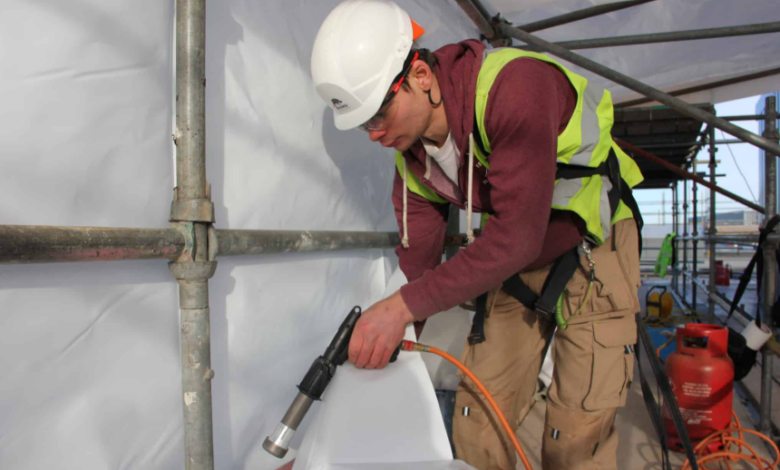The Role of Scaffold Shrink Wrap in Safer, Cleaner Job Sites

If you’ve ever walked past a construction site, you’ve probably noticed large white or clear plastic sheets tightly covering scaffolding. That material is called scaffold shrink wrap, and it’s quickly becoming one of the most important safety and cleanliness tools in the construction industry.
Why? Because today’s job sites demand more than just speed, they need to be safe, efficient, and environmentally responsible. Scaffold shrink wrap does all of that and more.
In this guide, we’ll break down what scaffold shrink wrap is, why it matters for both safety and cleanliness, and how flame-retardant options, like Heat Shrink Wrap Flame Retardant, add an extra layer of protection.
What is Scaffold Shrink Wrap?
Scaffold shrink wrap is a special type of heavy-duty plastic sheeting designed to tightly cover scaffolding structures on construction sites. It’s applied using heat, usually with a propane heat gun, which makes the plastic shrink and cling tightly to the scaffold.
Think of it like putting a protective skin around the entire structure. Unlike tarps or loose plastic sheets that flap in the wind, shrink wrap creates a smooth, sealed surface that’s tough, weather-resistant, and safe.
See also: AI Ad Tools vs. Agencies: 10 Reasons to Scale Smarter
Why Scaffold Shrink Wrap is Important on Job Sites
At first glance, it might look like simple plastic, but scaffold shrink wrap solves a lot of real problems contractors face every day. Here’s why it’s becoming standard in modern construction:
1. Improves Safety for Workers and the Public
Loose tarps can blow around in the wind, tear apart, or even fall off, creating hazards. Scaffold shrink wrap, on the other hand, stays tightly in place. This prevents accidents, keeps debris contained, and protects pedestrians walking nearby.
2. Keeps the Job Site Cleaner
Construction is messy. Dust, debris, and small particles can easily spread into surrounding areas. By sealing the site with shrink wrap, everything stays inside, keeping neighboring streets and properties clean.
3. Weather Protection
Rain, snow, and strong winds can cause serious delays. With scaffold shrink wrap, workers can continue building inside a protected “bubble.” It keeps the work environment dry, safe, and productive year-round.
4. Reduces Fire Risks with Flame-Retardant Options
Regular plastic can catch fire easily, which is dangerous on sites where welding, grinding, or electrical work is common. That’s why many contractors use Heat Shrink Wrap Flame Retardant. It resists flames, self-extinguishes when sparks hit it, and keeps projects compliant with fire safety regulations.
5. Better Project Efficiency
Cleaner, safer, and weather-protected job sites mean fewer interruptions, faster work, and fewer delays. That translates into real savings for contractors and project owners.
Scaffold Shrink Wrap vs. Traditional Covers
Some builders still use tarps or regular plastic sheets, but scaffold shrink wrap is in a completely different league. Let’s compare:
| Feature | Tarps/Plastic Sheets | Scaffold Shrink Wrap |
| Fit | Loose, often flaps in the wind | Tight, shrink-fitted to scaffolding |
| Durability | Tears easily in storms | Extremely durable and weather-resistant |
| Fire Resistance | Usually flammable | Available in flame-retardant options |
| Debris Containment | Poor – gaps allow dust/debris to escape | Excellent – sealed surface keeps everything inside |
| Safety | Can fall or blow away | Secure and long-lasting |
Clearly, scaffold shrink wrap is the smarter and safer investment.
Where Scaffold Shrink Wrap is Used
Scaffold shrink wrap isn’t just for big high-rise projects; it’s versatile enough for many situations, such as:
- High-rise construction – Keeps upper-level work safe and contained.
- Bridge and highway projects – Shields against weather and falling debris.
- Renovations in busy cities – Protects pedestrians and nearby businesses from dust.
- Industrial sites – Prevents sparks and debris from spreading.
- Temporary enclosures – Creates weatherproof “rooms” on job sites for storage or work areas.
In all of these uses, flame-retardant options (like Heat Shrink Wrap Flame Retardant) are often required to meet safety codes.
How Scaffold Shrink Wrap Improves Job Site Cleanliness
Beyond safety, scaffold shrink wrap also makes job sites cleaner and more professional-looking:
- No Dust Spreading – Construction dust is not only messy but can also cause health risks. Shrink wrap keeps it contained.
- Waste Control – Small debris doesn’t fly out into streets or neighboring yards.
- Better Appearance – A wrapped scaffold looks neat and professional compared to flapping tarps.
- Environmental Responsibility – Preventing dust and waste spread shows commitment to community and environmental care.
The Role of Heat Shrink Wrap Flame Retardant
One of the biggest concerns with plastic coverings is fire. Sparks from welding or grinding tools are common on construction sites. That’s why Heat Shrink Wrap Flame Retardant is a game-changer.
- It resists catching fire when sparks land on it.
- If a flame source is removed, it self-extinguishes.
- Meets OSHA and local fire safety standards.
- Provides peace of mind to contractors, workers, and clients.
In short, flame-retardant shrink wrap combines the protective benefits of scaffold shrink wrap with crucial fire safety features.
Cost vs. Benefits of Scaffold Shrink Wrap
Some might wonder if shrink wrap is worth the extra cost compared to simple tarps. Here’s the reality:
- Tarps are cheaper upfront, but tear easily, blow off, and pose safety risks. Replacing them repeatedly adds costs.
- Scaffold shrink wrap is more expensive at first but lasts longer, reduces delays, and improves safety.
When you factor in fewer accidents, cleaner sites, and uninterrupted work, scaffold shrink wrap often saves money in the long run.
Final Thoughts
In modern construction, safety and cleanliness aren’t optional; they’re must-haves. Scaffold shrink wrap plays a huge role in achieving both. It creates a sealed, weatherproof, and professional-looking job site that protects workers, the public, and the project itself.
And when paired with Heat Shrink Wrap Flame Retardant, it adds another layer of protection against one of the biggest risks on a construction site: fire.
For contractors and builders looking to stay safe, compliant, and efficient, scaffold shrink wrap is no longer just an option; it’s a necessity.
FAQs About Scaffold Shrink Wrap
1. What exactly is scaffold shrink wrap?
It’s a heavy-duty plastic that’s heated and shrunk tightly around scaffolding to create a safe, sealed work zone.
2. Why use shrink wrap instead of tarps?
Shrink wrap is stronger, doesn’t flap in the wind, contains dust/debris, and can be flame-retardant, making it much safer and cleaner than tarps.
3. Is scaffold shrink wrap reusable?
No, it’s designed for single use. Once removed, it’s typically recycled or disposed of.
4. How does Heat Shrink Wrap Flame Retardant help?
It prevents the material from easily catching fire, self-extinguishes when sparks hit it, and meets construction fire safety standards.
5. Is scaffold shrink wrap expensive?
It costs more upfront than tarps, but the safety, durability, and time savings usually make it the more cost-effective choice overall.



